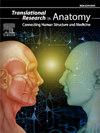A dissection and angiographic study of morphological variations in the anterior communicating artery complex in a South African sample
Q3 Medicine
引用次数: 0
Abstract
Background
The anterior communicating artery complex (ACAC), which includes the A1 and A2 segments of the anterior cerebral artery (ACA) and the anterior communicating artery (ACoA), is a common site for anatomical variation and aneurysm formation. While cerebral arterial variations have been linked to aneurysm development, limited data exists on these variations in the South African population.
Methods
This study assessed ACAC morphology through two components: dissection of 68 formalin-fixed adult brains (35 female, 33 male) and analysis of 200 adult magnetic resonance angiogram (MRA) scans (145 female, 55 male). Anatomical variations in the ACAC were recorded and evaluated for their prevalence and potential association with cerebral aneurysms.
Results
Variations in the ACAC were prevalent in 67.6 % of dissection specimens and 43.5 % of angiographic images. The most frequent variations of the ACoA observed in both dissection and angiographic samples were X-shaped formations and hypoplasia. In dissections, the A1 segment frequently displayed hypoplasia, duplication, and fenestration, while the A2 segment typically presented the 'anastomosed' variation. In angiographic scans, the A2 segment often exhibited a triple ACA configuration. A history of ACAC aneurysms was present in 23.9 % of MRA scans. However, no significant correlation was observed between ACAC variations and aneurysm presence.
Conclusion
This study demonstrates significant morphological diversity within the ACAC, including newly described variations, and highlights inconsistencies with existing literature regarding aneurysm association. These findings underscore the need for region-specific anatomical data to inform surgical planning and risk assessment in cerebrovascular interventions.
解剖和血管造影研究的形态变化的前交通动脉复合体在南非的样本
前交通动脉复合体(ACAC)包括大脑前动脉(ACA)和前交通动脉(ACoA)的A1和A2段,是解剖变异和动脉瘤形成的常见部位。虽然脑动脉变异与动脉瘤的发展有关,但在南非人群中关于这些变异的数据有限。方法通过解剖68例经福尔马林固定的成人大脑(女性35例,男性33例)和分析200例成人磁共振血管造影(MRA)扫描(女性145例,男性55例),对ACAC形态学进行了评估。记录ACAC的解剖变异,并评估其患病率及其与脑动脉瘤的潜在关联。结果67.6%的解剖标本和43.5%的血管造影图像存在ACAC变异。在解剖和血管造影样本中观察到的ACoA最常见的变化是x形形成和发育不全。在解剖中,A1节段经常表现为发育不全、重复和开窗,而A2节段通常表现为“吻合”变异。在血管造影扫描中,A2段通常表现为三ACA结构。23.9%的MRA扫描有ACAC动脉瘤病史。然而,ACAC变异与动脉瘤存在之间没有明显的相关性。本研究显示了ACAC内显著的形态多样性,包括新描述的变异,并强调了与现有文献关于动脉瘤关联的不一致。这些发现强调了在脑血管干预中需要特定区域的解剖数据来指导手术计划和风险评估。
本文章由计算机程序翻译,如有差异,请以英文原文为准。
求助全文
约1分钟内获得全文
求助全文
来源期刊

Translational Research in Anatomy
Medicine-Anatomy
CiteScore
2.90
自引率
0.00%
发文量
71
审稿时长
25 days
期刊介绍:
Translational Research in Anatomy is an international peer-reviewed and open access journal that publishes high-quality original papers. Focusing on translational research, the journal aims to disseminate the knowledge that is gained in the basic science of anatomy and to apply it to the diagnosis and treatment of human pathology in order to improve individual patient well-being. Topics published in Translational Research in Anatomy include anatomy in all of its aspects, especially those that have application to other scientific disciplines including the health sciences: • gross anatomy • neuroanatomy • histology • immunohistochemistry • comparative anatomy • embryology • molecular biology • microscopic anatomy • forensics • imaging/radiology • medical education Priority will be given to studies that clearly articulate their relevance to the broader aspects of anatomy and how they can impact patient care.Strengthening the ties between morphological research and medicine will foster collaboration between anatomists and physicians. Therefore, Translational Research in Anatomy will serve as a platform for communication and understanding between the disciplines of anatomy and medicine and will aid in the dissemination of anatomical research. The journal accepts the following article types: 1. Review articles 2. Original research papers 3. New state-of-the-art methods of research in the field of anatomy including imaging, dissection methods, medical devices and quantitation 4. Education papers (teaching technologies/methods in medical education in anatomy) 5. Commentaries 6. Letters to the Editor 7. Selected conference papers 8. Case Reports
 求助内容:
求助内容: 应助结果提醒方式:
应助结果提醒方式:


